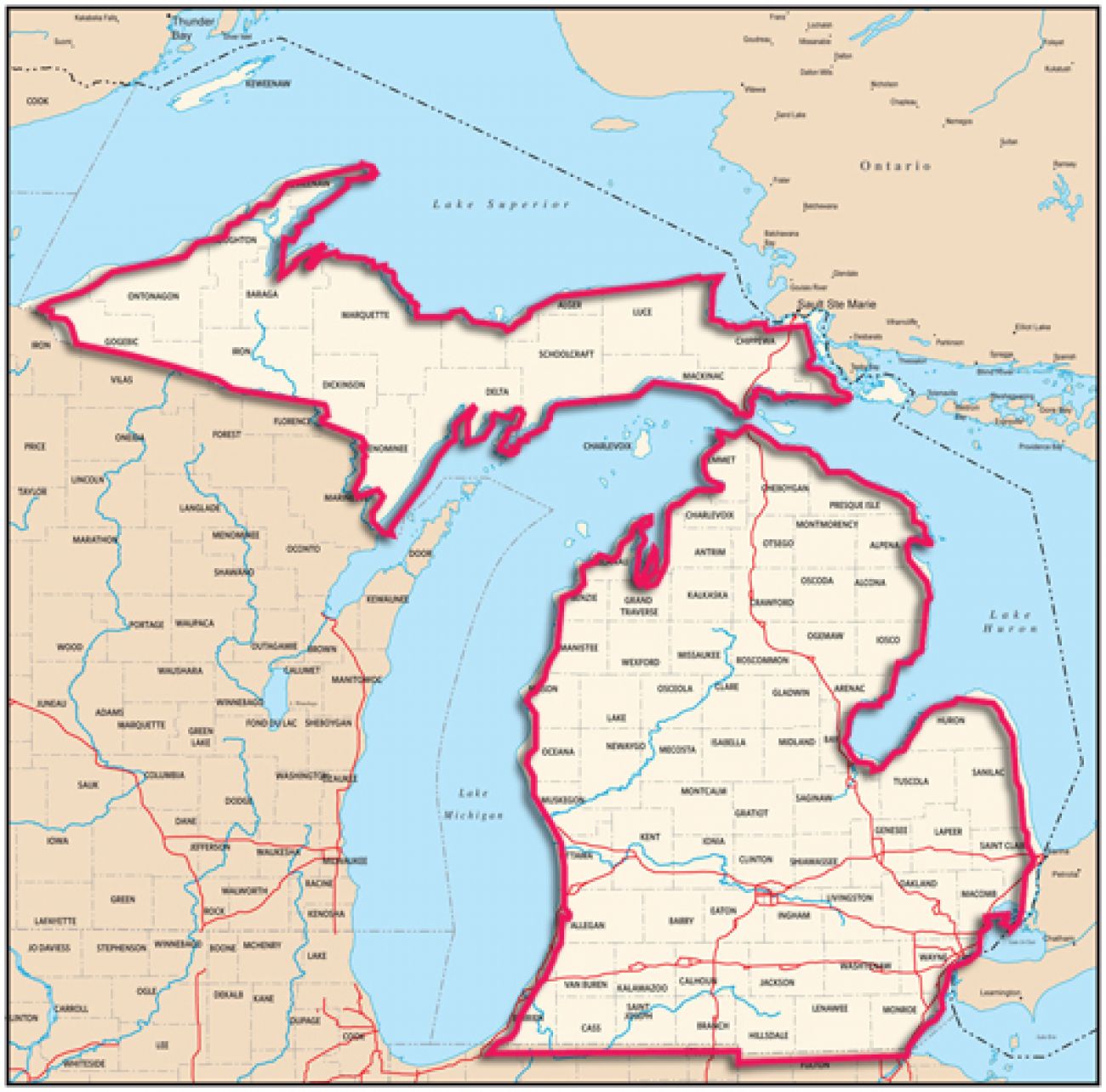Dreaming big: A walking trail spanning Michigan’s vast coastline

Michigan’s recreational trails offer jaw-dropping glimpses of the Great Lakes stretching out against the horizon. They feature cliffs that look like they were squirted with giant tubes of fingerpaint. And miles of soft sand to trudge ‒ a scenic way to tighten the glutes.
Wander off the public parks and more breath-taking vistas await (as well as the occasional trash-strewn shoreline, landfill or nuclear power plant).
This is the Michigan that author Loreen Niewenhuis experienced ‒ and more ‒ when she walked 3,000 miles around the Great Lakes and their islands from 2009 to 2014 and then wrote about her journey.
It’s the kind of journey that is an inspiration for the Next Big Idea for Michigan: A walking trail that traces the entire shoreline of the state.
Yes, that’s nearly 2,200 miles of trail around the Mitten and Upper Peninsula, the centerpiece of a 10,000-mile Great Lakes mega-route traversing eight states and Canada. To put a 2,200-mile Michigan trek in perspective, that’s roughly the length of the U.S.’s entire East Coast, from Maine through Florida.
“If Michigan leads, the rest of the Great Lakes states will follow. They’ll see what this could mean for local communities along the lake shore,” said Melissa Scanlan, an environmental law professor and leading proponent of ringing Michigan and the entire Great Lakes region with public-access trails.
Why would anyone want to walk thousands of miles along Michigan’s mostly delightful coastline? Because in Michigan, you can – at least theoretically.
Michigan law allows anyone to traverse the state’s coast along the water’s edge up to the ordinary high water mark of the land without being guilty of trespassing on private property.
That makes Michigan a good place to start building what could be the world’s longest public beachside walking trail, said Scanlan, a Wisconsin native who is now an associate professor and director of the Environmental Law Center at the Vermont Law School. Earlier this month, she pitched her idea, “Blueprint for the Great Lakes Trail,” in a talk at the University of Michigan law school in Ann Arbor.
It’s bold and fantastic to even think of carving a path along the length of the largest freshwater system on the planet. But perhaps it’s an idea whose time has come. This is, after all, what might be described as a golden era of outsized wanderlust, as depicted in splashy movies (“Wild,” about a woman’s 1,000 mile hike of the Pacific Crest Trail) and best-selling books (such as Bill Bryson’s “A Walk in the Woods,” about his journey along the Appalachian Trail).
Scanlan argues that a Michigan path could lead to improved tourism, economic development and job creation. Of course, you have to spend money to make money and neither Scanlan nor anyone else can put a price on planning and funding a vast project that could easily take decades to complete.
But Niewenhuis, perhaps the Michigan coast’s most popular adventurer, said the payoff could be priceless.
“By giving people access to the water, people will be more connected to it and care about it more,” she said.
Happy Trails
The Great Lakes shoreline crosses eight states in the U.S. and two provinces in Canada, spanning 6,582 miles around mainland, according to the Michigan Department of Environmental Quality. Include the shores around islands and connecting rivers and Michigan’s path would exceed 3,000 miles, while a Great Lakes coastline would top 10,000 miles, or more than three times the distance from New York to San Francisco.
Michigan already is home to hundreds of miles of hiking trails including more than 200 miles on the Shore-to-Shore Trail that connects Lake Huron to Lake Michigan. Then there’s the Iron Belle Trail, proposed by Gov. Rick Snyder in 2012, that will be a 1,259-mile hiking route and a 774-mile bicycling route connecting old and new trails. Much of it follows the existing 4,600-mile North Country National Scenic Trail that runs from the New York-Vermont border through Michigan to North Dakota.
The state Department of Natural Resources plans to have the Iron Belle completed by 2017. Some portions opened this year.
A Great Lakes walking trail would augment and connect to the thousands of miles of existing trails in Michigan, Scanlan said. It could also end up being longer than the North Country National Scenic Trail, that meanders through seven states. That trail was created in 1980 and is not yet complete.
The idea is as deep and wide as the lakes themselves, but not impossible.
In 1988, Canadians started working on the paved hiking and biking Waterfront Trail along the Great Lakes with the goal of going as close to the water as possible. It spans about 1,400 kilometers (870 miles) along the Canadian shores of Lake Ontario, Lake Erie, Lake St. Clair and the Niagara, Detroit and St. Lawrence Rivers.
Not yet complete, the Waterfront Trail is considered a tourist attraction that connects 68 communities with walking paths (which make up 21 percent of the trail), neighborhood streets (21 percent), and rural roads (58 percent).
Too big for Michigan?
Of 211 million visitors to Michigan tourist destinations in 2012 and 2013, about 5.5 percent said they hit the hiking trails, according to Pure Michigan, the official travel and tourism department in Michigan.
Dave Lorenz, spokesman for Pure Michigan, said he can imagine that hikers and beachcombers would love to be able to loop the state’s coastline on a public trail.
But he said he’s not sure that a trail would provide enough jobs and economic stimulus to make it worthwhile. The costs have yet to be researched. But long trails cost untold millions of dollars and involve private, public and conservation entities.
“It’s not on our top list of priorities. I personally want us to take care of what we have,” Lorenz said. “I’d be totally in favor, I’m just concerned about the cost. And the continued maintenance, that’s what gets you.”
Scanlan said she conceived the idea of a Great Lakes walking trail on a trip to the Sleeping Bear Dunes National Lakeshore in Empire, recently acknowledged as one of the most beautiful places in America. Walking along a beach, she ran across a no-trespassing sign that warned visitors to keep away from private land.
It turns out, not everyone is thrilled with breaking down barriers to public access along the state’s shoreline.
Marcia Wineberg, a director of a chapter of the Great Lakes Coalition that represents about 800 property owners along Lake Michigan, said a hiking trail on the shoreline presents a security and privacy threat to property owners because hikers don’t know where public domain stops and private property begins.
“The high water mark is a touchy subject,” she said. “I don't think there is a definite definition of it and I’m not sure that a lot of people who use the beaches know where it is.”
She said the coalition also is concerned about sand supply and erosion.
Since she bought her house in St. Joseph in 1975, Wineberg said about 100 feet of her property frontage has eroded, falling off into Lake Michigan ‒ along with two neighbor’s houses.
Fluctuating water levels could erode or cover parts of a public shoreline trail, she said. “It could be here today, gone tomorrow.”
Possible challenges from private property owners along the coast are not the only obstacle to a Great Lakes trail.
Dave Lemberg, a geography expert who mapped Lake Michigan along the Michigan coastline for a waterway trail for kayakers, said the natural barriers to a land trail are considerable: bluffs and cliffs, especially along the Upper Peninsula and in the Thumb; impassable invasive plant species take over some beaches; and, as Wineberg noted, water level fluctuations can swamp beach trails or redefine the high water mark that separates public and private land.
While Michigan has nearly 2,200 miles of Great Lakes mainland coast, not all of it can be traveled on foot.
“It would take a lot of effort to figure out the walkability of the shoreline,” said Lemberg, an associate professor in the Department of Geography at Western Michigan University.
That is not meant to discourage the creation of a Great Lakes Trail. “Everything is possible,” he said. “I think it hasn’t happened yet because people haven’t talked about it much.”
Opportunities, not challenges
Niewenhuis, the woman who has hiked most of Michigan’s shoreline, said private property owners and conservationists need not worry ‒ hikers would present few problems for the Great Lakes.
Niewenhuis used public access points to get to the Great Lakes shores, but because there is currently no public trail, once outside the public parks she had to improvise her own course along the water’s edge.
A Great Lakes trail would help educate the public on how to access the lakes and how to treat the lakes, she said. Along the water, hikers will be inspired and impressed by the water, the cliffs, the flora and fauna. They also may see a Superfund site formerly contaminated with asbestos, nuclear power plants, or areas that have “a toxic relationship with the lake.”
The decades of collaboration across industries, the research, as well as the millions in taxes and donations that will be required to make the Great Lakes Trail idea a reality could all be worth it if it brings people closer to the water’s edge, Niewenhuis said.
“Big ideas are important,” she said. “That’s how big things happen.”
See what new members are saying about why they donated to Bridge Michigan:
- “In order for this information to be accurate and unbiased it must be underwritten by its readers, not by special interests.” - Larry S.
- “Not many other media sources report on the topics Bridge does.” - Susan B.
- “Your journalism is outstanding and rare these days.” - Mark S.
If you want to ensure the future of nonpartisan, nonprofit Michigan journalism, please become a member today. You, too, will be asked why you donated and maybe we'll feature your quote next time!


 A Great Lakes walking trail around Michigan’s Mitten and Upper Peninsula would cover nearly 2,200 miles. Add shores around islands and connecting rivers and Michigan would have over 3,000 miles of Great Lakes paths.
A Great Lakes walking trail around Michigan’s Mitten and Upper Peninsula would cover nearly 2,200 miles. Add shores around islands and connecting rivers and Michigan would have over 3,000 miles of Great Lakes paths. Author Loreen Niewenhuis, 52, of Battle Creek, trekked 3,000 miles along the Great Lakes and their islands. She says a public walking trail along the Great Lakes shoreline is a big idea that could help protect the environment.
Author Loreen Niewenhuis, 52, of Battle Creek, trekked 3,000 miles along the Great Lakes and their islands. She says a public walking trail along the Great Lakes shoreline is a big idea that could help protect the environment.